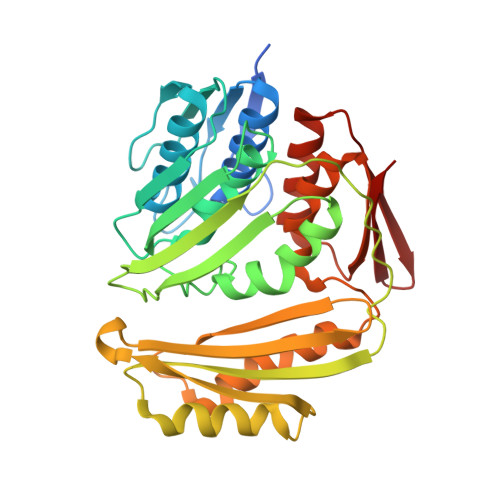Structures of RNA 3'-phosphate cyclase bound to ATP reveal the mechanism of nucleotidyl transfer and metal-assisted catalysis.
Chakravarty, A.K., Smith, P., Shuman, S.(2011) Proc Natl Acad Sci U S A 108: 21034-21039
- PubMed: 22167800
- DOI: https://doi.org/10.1073/pnas.1115560108
- Primary Citation of Related Structures:
3TUT, 3TUX, 3TV1, 3TW3 - PubMed Abstract:
RNA 3'-phosphate cyclase (RtcA) synthesizes RNA 2',3' cyclic phosphate ends via three steps: reaction with ATP to form a covalent RtcA-(histidinyl-Nε)-AMP intermediate; transfer of adenylate to an RNA 3'-phosphate to form RNA(3')pp(5')A; and attack of the vicinal O2' on the 3'-phosphorus to form a 2',3' cyclic phosphate and release AMP. Here we report the crystal structures of RtcA•ATP, RtcA•ATP•Mn(2+), and RtcA•ATP•Co(2+) substrate complexes and an RtcA•AMP product complex. Together with the structures of RtcA apoenzyme and the covalent RtcA-AMP intermediate, they illuminate the mechanism of nucleotidyl transfer, especially the stereochemical transitions at the AMP phosphate, the critical role of the metal in orienting the PP(i) leaving group of ATP during step 1, and the protein conformational switches that accompany substrate binding and product release. The octahedral metal complex of RtcA•ATP•Mn(2+) includes nonbridging oxygens from each of the ATP phosphates, two waters, and Glu14 as the sole RtcA component. Whereas the RtcA adenylylation step is metal-catalyzed, the subsequent steps in the cyclization pathway are metal-independent.
- Molecular Biology Program, Sloan-Kettering Institute, 1275 York Avenue, New York, NY 10065, USA.
Organizational Affiliation:




















